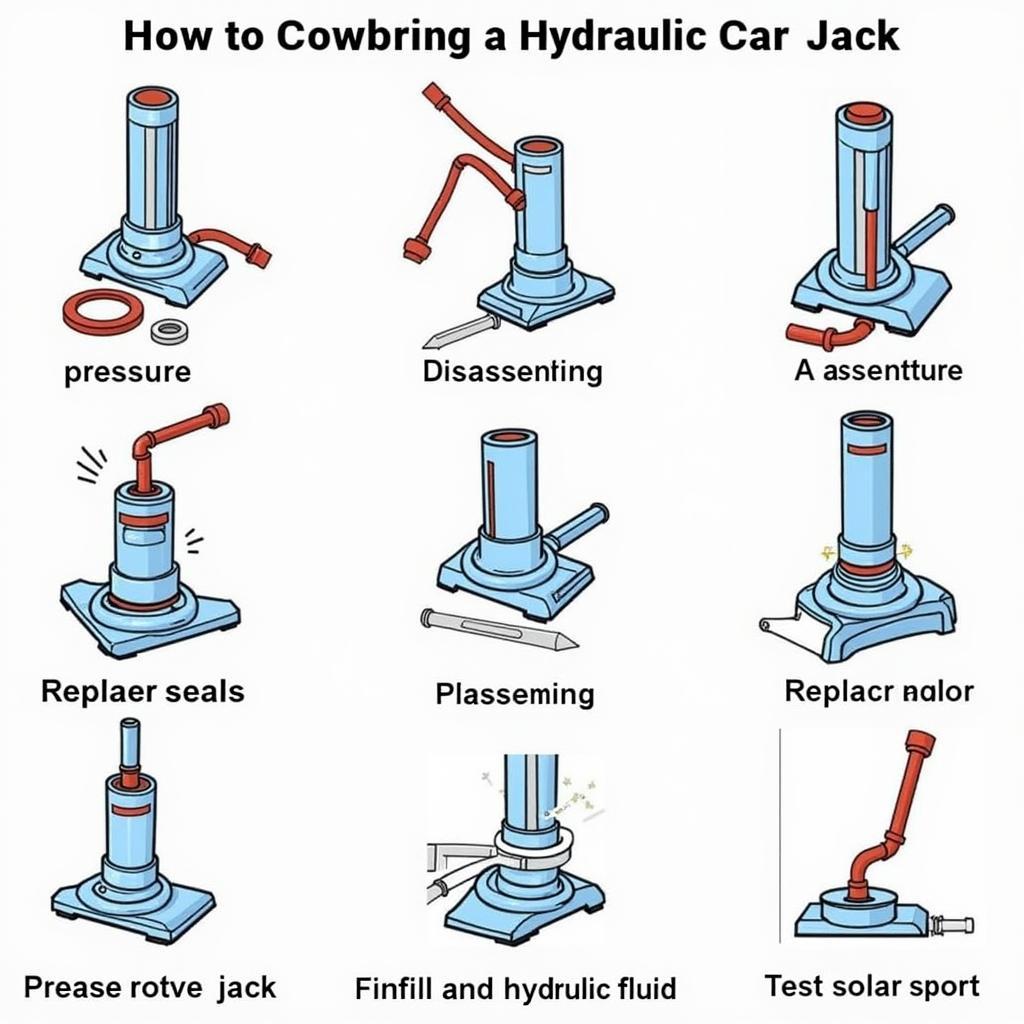A broken car jack can be a real headache, especially in an emergency. Knowing how to repair a car jack can save you time, money, and potentially a lot of frustration. This guide will walk you through common car jack problems and provide step-by-step instructions on how to fix them.
Repairing a car jack isn’t always as complicated as it seems. With the right tools and a bit of know-how, you can often get your jack back in working order. This guide covers various types of car jacks, including scissor jacks and hydraulic jacks, and offers practical advice for troubleshooting and repair. Check out our guide on how to repair hydraulic car jack for more specific information on hydraulic models.
Common Car Jack Problems and Solutions
Car jacks can malfunction for a variety of reasons. Here are some of the most common issues you might encounter:
- Leaking Hydraulic Fluid: This is a common problem with hydraulic jacks. The leak can be due to a damaged seal or a cracked cylinder.
- Bent or Damaged Frame: Scissor jacks are particularly susceptible to bending or damage if overloaded or used improperly.
- Sticking Mechanism: Rust, dirt, or lack of lubrication can cause the jack’s mechanism to stick or become difficult to operate.
- Worn or Damaged Parts: Over time, parts like the saddle, screw, or release valve can wear out or become damaged, affecting the jack’s performance.
How to Repair a Hydraulic Car Jack: Step-by-Step
If you’re dealing with a leaky hydraulic jack, here’s a step-by-step guide to help you fix it:
- Gather Your Tools: You’ll need a jack repair kit (which usually includes seals and O-rings), hydraulic jack oil, a wrench, and a drain pan.
- Release the Pressure: Lower the jack completely and open the release valve to relieve any remaining pressure.
- Disassemble the Jack: Carefully disassemble the jack according to the manufacturer’s instructions.
- Replace the Seals: Replace the old, worn-out seals with new ones from the repair kit.
- Reassemble the Jack: Reassemble the jack, ensuring all parts are properly aligned and tightened.
- Refill the Hydraulic Fluid: Refill the jack with fresh hydraulic jack oil to the appropriate level.
- Test the Jack: Test the jack to make sure it’s working correctly and that the leak is fixed.
 Repairing a Hydraulic Car Jack: Step-by-step guide
Repairing a Hydraulic Car Jack: Step-by-step guide
Repairing a Scissor Jack
Scissor jacks are relatively simple to repair. If the jack is bent, you might be able to straighten it using a hammer and a sturdy surface. However, if the damage is significant, it’s usually best to replace the jack. For other issues like a sticking mechanism, lubrication is often the key.
You might also be interested in our guide on how to repair car jack area for information on repairing the jack points on your vehicle.
Preventative Maintenance for Your Car Jack
Regular maintenance can prevent many car jack problems. Here are some tips to keep your jack in good working condition:
- Lubricate Regularly: Lubricate the moving parts of your jack with a suitable lubricant.
- Clean After Use: Clean your jack after each use to remove dirt and debris.
- Store Properly: Store your jack in a clean, dry place.
- Inspect Regularly: Inspect your jack regularly for signs of wear or damage.
John Smith, a seasoned mechanic with over 20 years of experience, advises, “Regularly lubricating your car jack is crucial for its longevity. A little maintenance goes a long way in preventing costly repairs down the road.”
How to Choose the Right Car Jack
Choosing the right car jack depends on your needs and the type of vehicle you own. Consider factors like weight capacity, lifting height, and ease of use. Looking for other car repair tips? See our guide on how to repair car engine starter.
Conclusion
Knowing how to repair a car jack is a valuable skill for any car owner. By following the steps outlined in this guide, you can often fix common problems yourself, saving you time and money. Remember to prioritize safety and always consult the manufacturer’s instructions before attempting any repairs. If you’re unsure about anything, it’s always best to consult a qualified mechanic. For basic car repair essentials, check out what are basic things need for car and bike repair. Understanding how to repair your car jack is an essential part of vehicle maintenance.
Maria Garcia, a leading automotive engineer, emphasizes, “Choosing the right type of car jack is paramount for safety and efficiency. Make sure the jack’s capacity exceeds your vehicle’s weight.” You can find more information on car repair in Hindi in our article on how to car repairing in hindi.
FAQ
- What type of oil should I use for my hydraulic jack? Use hydraulic jack oil specifically designed for car jacks.
- How often should I lubricate my car jack? Lubricate your jack at least once a year, or more frequently if used often.
- Can I repair a bent scissor jack? Minor bends can sometimes be straightened, but significant damage warrants replacement.
- Where can I find replacement parts for my car jack? Auto parts stores or online retailers often carry car jack repair kits.
- Is it safe to repair a car jack myself? Yes, if you follow safety precautions and consult the manufacturer’s instructions.
- What should I do if my car jack is leaking fluid? Stop using the jack immediately and attempt to repair or replace it.
- How do I know if my car jack is worn out? Look for signs of wear and tear, such as rust, cracks, or difficulty operating the jack.
Need Help? Contact Us!
For any assistance or inquiries, don’t hesitate to reach out to our 24/7 customer support team via WhatsApp: +1(641)206-8880 or Email: [email protected].

Leave a Reply